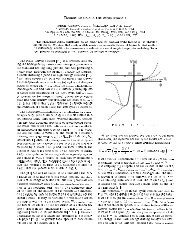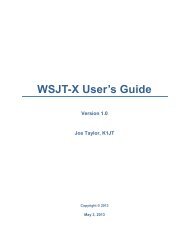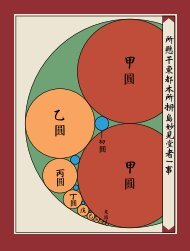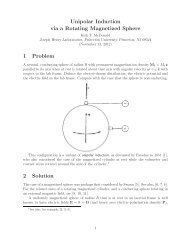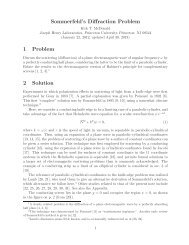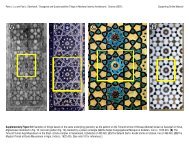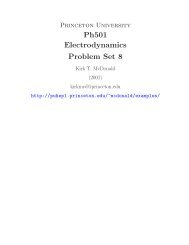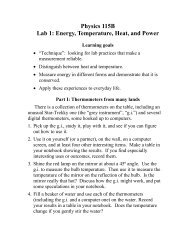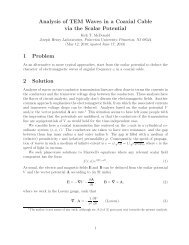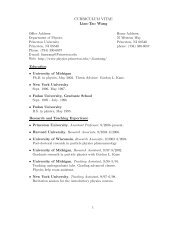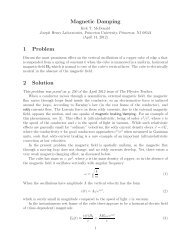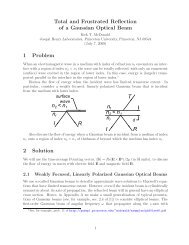Lectures on flavor superfluidity & superconductivity
Lectures on flavor superfluidity & superconductivity
Lectures on flavor superfluidity & superconductivity
You also want an ePaper? Increase the reach of your titles
YUMPU automatically turns print PDFs into web optimized ePapers that Google loves.
Flavor Superc<strong>on</strong>ductivity/<br />
Superfluidity<br />
Fifth Aegean Summer School, Adamas, Milos, September 2009<br />
q<br />
¯q<br />
AdS/CFT<br />
[arXiv: 0810.2316]<br />
[arXiv: 0903.1864]<br />
by Matthias Kaminski (IFT-UAM/CSIC Madrid)<br />
in collaborati<strong>on</strong> with M.Amm<strong>on</strong>, J.Erdmenger, P.Kerner (MPI Munich)
Outline<br />
I. Invitati<strong>on</strong>: Superc<strong>on</strong>ductivity & Holography<br />
II. Review: Holographic C<strong>on</strong>cepts<br />
III. Details: Flavored Plasma (D3/D7)<br />
IV. Results: Flavor Superc<strong>on</strong>ducting Phase (D3/D7)<br />
V. Discussi<strong>on</strong><br />
Remarks <strong>on</strong> references:<br />
All references are hyperlinked in this document.<br />
Publicati<strong>on</strong>s quoted here are chosen because they review or explain certain<br />
aspects in a (pedagogical) way which is accessible to the unexperienced reader.<br />
Matthias Kaminski Flavor Superc<strong>on</strong>ductivity/Superfluidity Page<br />
2
I. Invitati<strong>on</strong>: C<strong>on</strong>venti<strong>on</strong>al Superc<strong>on</strong>ductors<br />
Examples<br />
Color superc<strong>on</strong>ducting phase at high densities<br />
[Alford, Rajagopal, Wilczek ‘97]<br />
Higgs mechanism: Superc<strong>on</strong>ductivity of vacuum<br />
Weak coupling c<strong>on</strong>cepts<br />
charged c<strong>on</strong>densate of Cooper-pairs<br />
(gauge) symmetry: electromagnetic U(1) em<br />
local symmetry sp<strong>on</strong>taneously broken<br />
Goldst<strong>on</strong>e bos<strong>on</strong>s eaten<br />
[see lectures by Horowitz]<br />
[e.g.Weinberg]<br />
(phot<strong>on</strong>s in SC become massive Meissner effect)<br />
Theory: BCS (Bardeen-Cooper-Schrieffer) well established<br />
Superfluidity: global symmetry sp<strong>on</strong>taneously broken,<br />
Goldst<strong>on</strong>e bos<strong>on</strong>s survive (become hydro modes)<br />
weakly gauge boundary theory<br />
Matthias Kaminski Flavor Superc<strong>on</strong>ductivity/Superfluidity Page 3
I. Invitati<strong>on</strong>: Unc<strong>on</strong>venti<strong>on</strong>al Superc<strong>on</strong>ductors<br />
[see talk by Panagopoulos]<br />
Typical signatures<br />
magnetic field expulsi<strong>on</strong> (c)<br />
energy gap (peak at edge)<br />
pseudo gap<br />
underdoped: str<strong>on</strong>g coupl.<br />
T c<br />
Figure: Tunneling spectra measured in<br />
high temperature<br />
superc<strong>on</strong>ductor Bi 2 Sr 2 CaCu 2 O 8+δ .<br />
[Renner et al., Phys. Rev. Lett. 80,<br />
149 - 152 (1998)]<br />
Theory? Pairing mechanism? Meissner effect?<br />
[see lectures by Sadchdev]<br />
Matthias Kaminski Flavor Superc<strong>on</strong>ductivity/Superfluidity Page 4
I. Invitati<strong>on</strong>: Unc<strong>on</strong>venti<strong>on</strong>al Superc<strong>on</strong>ductors<br />
[see talk by Panagopoulos]<br />
Holographic result<br />
Typical signatures<br />
Energy gap<br />
Re σ<br />
4πw<br />
sigma4Piw<br />
magnetic field expulsi<strong>on</strong> (c)<br />
1.4<br />
energy gap (peak at edge)<br />
1.2<br />
pseudo gap<br />
1.0<br />
underdoped: str<strong>on</strong>g coupl.<br />
0.8<br />
0.6<br />
0.4<br />
Preview<br />
Figure: Tunneling spectra measured in<br />
0.2<br />
high temperature<br />
superc<strong>on</strong>ductor Bi 2 Sr 2 CaCu 2 O 8+δ .<br />
0.0<br />
0 5 10 15 20 w<br />
[Renner et al., Phys. Rev. Lett. 80,<br />
149 - 152 (1998)]<br />
w<br />
T c<br />
Theory? Pairing mechanism? Meissner effect?<br />
[see lectures by Sadchdev]<br />
Matthias Kaminski Flavor Superc<strong>on</strong>ductivity/Superfluidity Page 4
I. Invitati<strong>on</strong>: Building a Holographic SC<br />
Field Theory<br />
Gravity<br />
[Gubser, Pufu 0805.2960]<br />
What do we need?<br />
AdS-boundary<br />
c<strong>on</strong>densate<br />
curvature<br />
electromag.<br />
charged c<strong>on</strong>densate (vev)<br />
no source<br />
c<strong>on</strong>densate of charge carriers<br />
finite temperature<br />
horiz<strong>on</strong><br />
gravity<br />
introduce normalizble mode<br />
no n<strong>on</strong>-normalizable mode<br />
c<strong>on</strong>densate hovers over horiz<strong>on</strong><br />
black hole<br />
Is this stable?<br />
Matthias Kaminski Flavor Superc<strong>on</strong>ductivity/Superfluidity Page 5
I. Invitati<strong>on</strong>: Get some intuiti<strong>on</strong><br />
Field Theory<br />
Gravity<br />
L ∼ D ν φD ν φ ∼ (M q 2 − µ isospin 2 )φ 2<br />
5<br />
4<br />
VΦ<br />
3<br />
2<br />
1<br />
0<br />
-2 -1 0 1 2<br />
Φ<br />
charged particles c<strong>on</strong>dense at<br />
large enough chemical potential<br />
µ isopin ∼ M q<br />
strings (D3-D7) give FT charges<br />
cannot put infinitely many<br />
sec<strong>on</strong>d brane is important<br />
Why do we need a n<strong>on</strong>-Abelian structure?<br />
Matthias Kaminski Flavor Superc<strong>on</strong>ductivity/Superfluidity Page 6
I. Invitati<strong>on</strong>: Get some intuiti<strong>on</strong><br />
Field Theory<br />
Gravity<br />
L ∼ D ν φD ν φ ∼ (M q 2 − µ isospin 2 )φ 2<br />
1<br />
VΦ<br />
0.5<br />
0<br />
-0.5<br />
-2 -1 0 1 2<br />
Φ<br />
charged particles c<strong>on</strong>dense at<br />
large enough chemical potential<br />
µ isopin ∼ M q<br />
strings (D3-D7) give FT charges<br />
cannot put infinitely many<br />
sec<strong>on</strong>d brane is important<br />
Why do we need a n<strong>on</strong>-Abelian structure?<br />
Matthias Kaminski Flavor Superc<strong>on</strong>ductivity/Superfluidity Page 6
I. Invitati<strong>on</strong>: Why so complicated?<br />
Bottom-up<br />
Top-down<br />
String Theory<br />
?<br />
Phenomenological<br />
Gravity Dual of SC<br />
Phenomenological<br />
requirements,<br />
SC Field Theory<br />
[Gubser, Pufu 0805.2960]<br />
[Hartnoll, Herzog, Horowitz 0803.3295]<br />
study effects in clean setup<br />
seperate effects<br />
[see lectures by Horowitz]<br />
String Theory<br />
Geometric c<strong>on</strong>structi<strong>on</strong><br />
(e.g. Dp/Dq-branes)<br />
Holographic Dual of SC<br />
string theory derived<br />
identificati<strong>on</strong> of FT degrees o.f.<br />
‘dirty’<br />
many effects at <strong>on</strong>ce<br />
Pairing mechanism!<br />
[0810.2316]<br />
[0903.1864]<br />
Matthias Kaminski Flavor Superc<strong>on</strong>ductivity/Superfluidity Page 7
Navigator<br />
✓ Invitati<strong>on</strong>: Superc<strong>on</strong>ductivity & Holography<br />
II. Review: Holographic C<strong>on</strong>cepts<br />
also reviewed in [M.K. 0808.1114]<br />
III. Details: Flavored Plasma (D3/D7)<br />
IV. Results: Flavor Superc<strong>on</strong>ducting Phase (D3/D7)<br />
V. Discussi<strong>on</strong><br />
Matthias Kaminski Flavor Superc<strong>on</strong>ductivity/Superfluidity Page<br />
8
II. Review: Boundary Asymptotics<br />
n<strong>on</strong>-normalizable<br />
(source)<br />
normalizable<br />
(vev)<br />
A = A (0) + A(2)<br />
ρ 2 + . . .<br />
(ρ → ∞)<br />
ρ<br />
AdS<br />
QFT<br />
ρ bdy<br />
[see lectures by Argyres]<br />
Dicti<strong>on</strong>ary<br />
QFT FEATURE<br />
(energy scale)<br />
GEOMETRY<br />
(radial coord. )<br />
ρ<br />
operator J µ field A µ (gauge)<br />
vev A (2) (charge)<br />
source A (0) (chem. pot.)<br />
Matthias Kaminski Flavor Superc<strong>on</strong>ductivity/Superfluidity Page<br />
9
II. Review: Correlators & Spectral Functi<strong>on</strong>s<br />
˜J µ<br />
J µ A µ<br />
δ 2<br />
w<br />
Gauge Theory<br />
Problem (str<strong>on</strong>g):<br />
Find retarded twopoint<br />
functi<strong>on</strong> of<br />
<strong>flavor</strong> current<br />
in YM-plasma.<br />
Gravity problem<br />
(weak):<br />
Find soluti<strong>on</strong> for<br />
equati<strong>on</strong> of moti<strong>on</strong><br />
of vector field<br />
in SUGRA.<br />
ret<br />
δA bdy δA bdy<br />
S Sugra<br />
Recipe:<br />
S Sugra ∼<br />
∫<br />
∂ ρ A ∂ ρ A<br />
S <strong>on</strong>-shell ∼<br />
∫<br />
A ∂ ρ A<br />
G ret ∼ lim<br />
ρ→∞<br />
A<br />
A<br />
∂ ρ A<br />
A<br />
Thermal spectral functi<strong>on</strong>:<br />
[S<strong>on</strong>,Starinets hep-th/0205051]<br />
R(ω, q) = −2 ImG ret (ω, q)<br />
Matthias Kaminski Flavor Superc<strong>on</strong>ductivity/Superfluidity Page<br />
10
II. Review: Quasinormal modes<br />
ω n ∈ C<br />
Special frequencies:<br />
;<br />
(quasinormal)<br />
e −iωr = e −iRe{ω}r e Im{ω}r<br />
Example:<br />
G ret = N f N c T 2<br />
lim |Ã(ω n)| 2 = 0<br />
ρ→ρ bdy<br />
8<br />
[Berti et al. 0905.2975]<br />
( )<br />
lim ρ 3 ∂ρÃ(ρ)<br />
ρ→ρ bdy Ã(ρ)<br />
R = −2 Im G ret<br />
R<br />
ω 2<br />
ω 1<br />
ω 0<br />
Gravity:<br />
quasinormal<br />
frequencies<br />
Gauge theory:<br />
poles of correlator<br />
(energy, damping, stability<br />
of mes<strong>on</strong>ic excitati<strong>on</strong>s)<br />
Matthias Kaminski Flavor Superc<strong>on</strong>ductivity/Superfluidity Page 11
II. Review: D3/D7-Brane Setup (1)<br />
Flavor Probe Branes (D7)<br />
0123<br />
4567<br />
89<br />
N D3<br />
c<strong>on</strong>venti<strong>on</strong>al<br />
open/closed string duality<br />
SYM<br />
3!3<br />
AdS 5<br />
distinct approaches:<br />
[lectures by Kiritsis]<br />
[talk by Cotr<strong>on</strong>e]<br />
N probe D7<br />
f<br />
quarks<br />
3!7<br />
flavour open/open<br />
string duality<br />
Dirac-Born-Infeld (DBI) acti<strong>on</strong><br />
S DBI = −T 7<br />
∫<br />
d 8 σ<br />
R 4<br />
7!7<br />
AdS 5<br />
brane<br />
[Karch, Katz hep-th/0205236]<br />
Review: [Erdmenger et al. 0711.4467]<br />
(√− det(P [G + B] µν + (2πα ′ ) 2 )F µν<br />
)<br />
B ≡ 0<br />
Matthias Kaminski Flavor Superc<strong>on</strong>ductivity/Superfluidity Page 12
II. Review: D3/D7-Brane Setup (2)<br />
N c<br />
D3-branes<br />
Matthias Kaminski Flavor Superc<strong>on</strong>ductivity/Superfluidity Page 13
II. Review: D3/D7-Brane Setup (2)<br />
N f<br />
D7-branes<br />
N c<br />
D3-branes<br />
Matthias Kaminski Flavor Superc<strong>on</strong>ductivity/Superfluidity Page 13
II. Review: D3/D7-Brane Setup (2)<br />
N f<br />
D7-branes<br />
N c<br />
D3-branes<br />
(black)<br />
Matthias Kaminski Flavor Superc<strong>on</strong>ductivity/Superfluidity Page 13
II. Review: D3/D7-Brane Setup (2)<br />
N f<br />
D7-branes<br />
N c<br />
D3-branes<br />
(black)<br />
Matthias Kaminski Flavor Superc<strong>on</strong>ductivity/Superfluidity Page 13
II. Review: D3/D7-Brane Setup (2)<br />
 ν<br />
⊂ U(N f )<br />
N f<br />
D7-branes<br />
N c<br />
D3-branes<br />
(black)<br />
Matthias Kaminski Flavor Superc<strong>on</strong>ductivity/Superfluidity Page 13
II. Review: D3/D7-Brane Setup (2)<br />
 ν<br />
⊂ U(N f )<br />
ρ<br />
N f<br />
D7-branes<br />
L(ρ)<br />
0 1 2 3 4 5 6 7 8 9<br />
D3 x x x x<br />
D7 x x x x x x x x<br />
8,9<br />
N c<br />
D3-branes<br />
(black)<br />
4,5,6,7<br />
Matthias Kaminski Flavor Superc<strong>on</strong>ductivity/Superfluidity Page 13
II. Review: D3/D7-Brane Setup (2)<br />
 ν<br />
⊂ U(N f )<br />
ρ<br />
N f<br />
D7-branes<br />
L(ρ)<br />
0 1 2 3 4 5 6 7 8 9<br />
D3 x x x x<br />
D7 x x x x x x x x<br />
8,9<br />
N c<br />
D3-branes<br />
(black)<br />
4,5,6,7<br />
Chemical potential:  µ = δ µ0 A 0 + õ<br />
[Kobayashi et al. hep-th/0611099]<br />
[Mateos et al. 0709.1225]<br />
(cf. therm. FT)<br />
Matthias Kaminski Flavor Superc<strong>on</strong>ductivity/Superfluidity Page 13
II. Review: D3/D7-Brane Setup (2)<br />
 ν<br />
⊂ U(N f )<br />
ρ<br />
N f<br />
D7-branes<br />
L(ρ)<br />
0 1 2 3 4 5 6 7 8 9<br />
D3 x x x x<br />
D7 x x x x x x x x<br />
8,9<br />
N c<br />
D3-branes<br />
(black)<br />
4,5,6,7<br />
Chemical potential:  µ = δ µ0 A 0 + õ<br />
[Kobayashi et al. hep-th/0611099]<br />
[Mateos et al. 0709.1225]<br />
(cf. therm. FT)<br />
Matthias Kaminski Flavor Superc<strong>on</strong>ductivity/Superfluidity Page 13
II. Review: D3/D7-Brane Setup (2)<br />
Mes<strong>on</strong>s<br />
 ν<br />
⊂ U(N f )<br />
ρ<br />
N f<br />
D7-branes<br />
L(ρ)<br />
0 1 2 3 4 5 6 7 8 9<br />
D3 x x x x<br />
D7 x x x x x x x x<br />
8,9<br />
N c<br />
D3-branes<br />
(black)<br />
4,5,6,7<br />
Chemical potential:  µ = δ µ0 A 0 + õ<br />
[Kobayashi et al. hep-th/0611099]<br />
[Mateos et al. 0709.1225]<br />
(cf. therm. FT)<br />
Matthias Kaminski Flavor Superc<strong>on</strong>ductivity/Superfluidity Page 13
Navigator<br />
✓ Invitati<strong>on</strong>: Superc<strong>on</strong>ductivity & Holography<br />
✓ Review: Holographic C<strong>on</strong>cepts<br />
III. Details: Flavored Plasma (D3/D7)<br />
IV. Results: Flavor Superc<strong>on</strong>ducting Phase (D3/D7)<br />
V. Discussi<strong>on</strong><br />
Matthias Kaminski Flavor Superc<strong>on</strong>ductivity/Superfluidity Page<br />
14
III. Abelian Chemical Potential: Background<br />
AdS black hole metric<br />
pullback<br />
Induced metric <strong>on</strong> D7-brane<br />
[Myers et al. hep-th/0611099]<br />
f(ϱ) = 1 − ϱ H 4<br />
DBI acti<strong>on</strong><br />
4<br />
ϱ H ˜f(ϱ)<br />
ϱ = 1 + ϱ 2 = r 2 + √ r 4 − r<br />
4<br />
4 , χ = cos(θ)<br />
H<br />
ϱ 4 , ,<br />
0.0002<br />
p0<br />
0.00015<br />
0.0001<br />
0.00005<br />
0<br />
0 10 20 30 40 50<br />
ρ<br />
Can be rewritten as<br />
c<strong>on</strong>stant of moti<strong>on</strong> . ˜d<br />
Matthias Kaminski Flavor Superc<strong>on</strong>ductivity/Superfluidity Page 15
III. Abelian Chemical Potential: Fluctuati<strong>on</strong>s<br />
∫ ∣∣∣<br />
DBI acti<strong>on</strong>: S D7 = d x√ 8 det{[g + F ] + ˜F } ∣ F µν = ∂ [µ A ν]<br />
Equati<strong>on</strong> of moti<strong>on</strong>:<br />
[Myers,Starinets,Thoms<strong>on</strong> 0710.0334]<br />
} {{ }<br />
G<br />
0 = Ã′′ + ∂ ρ[ √ | det G|G 22 G 44 ]<br />
√<br />
| det G|G<br />
22<br />
G 44<br />
,<br />
à ′ − G00<br />
G 44 ϱ H 2 ω 2 Ã<br />
Matthias Kaminski Flavor Superc<strong>on</strong>ductivity/Superfluidity Page 16
III. Abelian Chemical Potential: Fluctuati<strong>on</strong>s<br />
∫ ∣∣∣<br />
DBI acti<strong>on</strong>: S D7 = d x√ 8 det{[g + F ] + ˜F } ∣ F µν = ∂ [µ A ν]<br />
Equati<strong>on</strong> of moti<strong>on</strong>:<br />
} {{ }<br />
G<br />
0 = Ã′′ + ∂ ρ[ √ `Curved’ Maxwell | det G|G 22 G 44 ]<br />
√ equati<strong>on</strong>s: Ã ′ − G00<br />
| det G|G<br />
22<br />
G 44 G 44 ϱ H 2 ω 2 Ã<br />
∂ µ F µν = 0<br />
[Myers,Starinets,Thoms<strong>on</strong> 0710.0334]<br />
∂ µ<br />
( √−GG µν G ρσ F νσ<br />
)<br />
= 0<br />
∂ µ<br />
( √−GG µν G ρσ ∂ [ν Ã σ]<br />
)<br />
= 0<br />
,<br />
Matthias Kaminski Flavor Superc<strong>on</strong>ductivity/Superfluidity Page 16
III. Abelian Chemical Potential: Fluctuati<strong>on</strong>s<br />
DBI acti<strong>on</strong>:<br />
Equati<strong>on</strong> of moti<strong>on</strong>:<br />
S D7 =<br />
∫<br />
[Myers,Starinets,Thoms<strong>on</strong> 0710.0334]<br />
∣∣∣<br />
d x√ 8 det{[g + F ] + ˜F } ∣<br />
} {{ }<br />
G<br />
0 = Ã′′ + ∂ ρ[ √ | det G|G 22 G 44 ]<br />
√<br />
| det G|G<br />
22<br />
G 44<br />
,<br />
F µν = ∂ [µ A ν]<br />
à ′ − G00<br />
G 44 ϱ H 2 ω 2 Ã<br />
Boundary c<strong>on</strong>diti<strong>on</strong>s:<br />
shooting from<br />
horiz<strong>on</strong><br />
Translati<strong>on</strong> to gauge theory by duality:<br />
Gauge correlator:<br />
[S<strong>on</strong>,Starinets<br />
hep-th/0205051]<br />
à = (ϱ − ϱ H ) −iw [1 + iw 2 (ϱ − ϱ H) + . . . ]<br />
G ret = N f N c T 2<br />
8<br />
AdS/CFT<br />
A µ ↔ J µ<br />
(source)<br />
(<br />
lim ρ 3 ∂ρÃ(ρ)<br />
ρ→ρ bdy Ã(ρ)<br />
Matthias Kaminski Flavor Superc<strong>on</strong>ductivity/Superfluidity Page 16<br />
)
III. Abelian Chemical Potential: Spectral F’s<br />
Finite bary<strong>on</strong> density:<br />
[Erdmenger, M.K., Rust 0710.0334]<br />
( , 0) − 0<br />
4<br />
2<br />
0<br />
2<br />
4<br />
˜d = 0.25<br />
χ 0 = 0.1<br />
χ 0 = 0.5<br />
χ 0 = 0.7<br />
χ 0 = 0.8<br />
6<br />
0.0 0.5 1.0 1.5 2.0 2.5<br />
[Karch, O’Bann<strong>on</strong> ‘07]<br />
µq/mq<br />
Phase diagram:<br />
0.8<br />
0.6<br />
0.4<br />
0.2<br />
1<br />
˜d = 0<br />
0.2<br />
˜d = 4<br />
0.4<br />
T/ ¯M<br />
0.6<br />
˜d = 0.25<br />
˜d = 0.00315<br />
0.8<br />
1<br />
L(ϱ) = ϱ χ(ϱ)<br />
χ 0 = χ(ρ) ∣ ∣<br />
ρ→ρH<br />
∼ m quark<br />
T<br />
χ = χ( ˜d , ρ)<br />
Matthias Kaminski Flavor Superc<strong>on</strong>ductivity/Superfluidity Page 17
III. Abelian Chemical Potential: Spectral F’s<br />
Finite bary<strong>on</strong> density:<br />
[Erdmenger, M.K., Rust 0710.0334]<br />
Lower temperature<br />
[Karch, O’Bann<strong>on</strong> ‘07]<br />
µq/mq<br />
Phase diagram:<br />
0.8<br />
0.6<br />
0.4<br />
0.2<br />
1<br />
˜d = 0<br />
0.2<br />
˜d = 4<br />
0.4<br />
T/ ¯M<br />
0.6<br />
˜d = 0.25<br />
˜d = 0.00315<br />
0.8<br />
1<br />
L(ϱ) = ϱ χ(ϱ)<br />
χ 0 = χ(ρ) ∣ ∣<br />
ρ→ρH<br />
∼ m quark<br />
T<br />
χ = χ( ˜d , ρ)<br />
Matthias Kaminski Flavor Superc<strong>on</strong>ductivity/Superfluidity Page 17
( , 0) − 0<br />
III. Abelian Chemical Potential: Spectral F’s<br />
Finite bary<strong>on</strong> density:<br />
200<br />
150<br />
100<br />
50<br />
0<br />
˜d = 0.25<br />
χ 0 = 0.8<br />
χ 0 = 0.94<br />
χ 0 = 0.962<br />
50<br />
0.0 0.5 1.0 1.5 2.0 2.5 3.0 3.5<br />
( , 0)<br />
140 000<br />
120 000<br />
100 000<br />
80 000<br />
60 000<br />
40 000<br />
20 000<br />
[Erdmenger, M.K., Rust 0710.0334]<br />
˜d = 0.25<br />
χ 0 = 0.999<br />
n = 0 n = 1 n = 2 n = 3<br />
0<br />
0 5 10 15 20 25 30 35<br />
[Karch, O’Bann<strong>on</strong> ‘07]<br />
µq/mq<br />
Phase diagram:<br />
0.8<br />
0.6<br />
0.4<br />
0.2<br />
1<br />
˜d = 0<br />
0.2<br />
˜d = 4<br />
0.4<br />
T/ ¯M<br />
0.6<br />
˜d = 0.25<br />
˜d = 0.00315<br />
0.8<br />
1<br />
L(ϱ) = ϱ χ(ϱ)<br />
χ 0 = χ(ρ) ∣ ∣<br />
ρ→ρH<br />
∼ m quark<br />
T<br />
χ = χ( ˜d , ρ)<br />
Matthias Kaminski Flavor Superc<strong>on</strong>ductivity/Superfluidity Page 17
III. Isospin Chemical Potential: Spectral F’s<br />
[Erdmenger, M.K., Rust 0710.0334]<br />
Finite isospin density<br />
What has changed?<br />
− 0<br />
4000<br />
3000<br />
2000<br />
1000<br />
0<br />
XY<br />
E 3 E 3 Y X<br />
n = 0<br />
n = 0 n = 0<br />
XY E 3 E 3 Y X<br />
n = 1 n = 1 n = 1<br />
2 4 6 8 10<br />
Background acti<strong>on</strong> c<strong>on</strong>tains<br />
tr( √ g + F a T a ) ∼ N f × Abelian<br />
Diag<strong>on</strong>alize acti<strong>on</strong> in <strong>flavor</strong><br />
space (X, Y, E)<br />
triplet splitting<br />
analog to Rho-vector mes<strong>on</strong><br />
analytical results & interpretati<strong>on</strong>:<br />
[M.K. 0808.1114]<br />
Fluctuati<strong>on</strong>s in three <strong>flavor</strong><br />
directi<strong>on</strong>s, so two new:<br />
X, Y (orthog<strong>on</strong>al to isospin)<br />
0 = X ′′ + . . . X ′ + . . . (ω − µ)X<br />
0 = Y ′′ + . . . Y ′ + . . . (ω + µ)Y<br />
Matthias Kaminski Flavor Superc<strong>on</strong>ductivity/Superfluidity Page 18
III. High isospin densities: Instability!<br />
[Erdmenger, M.K., Kerner, Rust 0807.2663]<br />
New (lowest) mes<strong>on</strong>ic excitati<strong>on</strong>:<br />
New phase:<br />
Stability:<br />
Matthias Kaminski Flavor Superc<strong>on</strong>ductivity/Superfluidity Page 19
First summary: QGP Phenomenology<br />
✓ stable mes<strong>on</strong>s survive dec<strong>on</strong>finement<br />
✓ mes<strong>on</strong> mass changes with temperature<br />
✓ vec-mes<strong>on</strong>s are isospin triplets (QCD’s Rho-mes<strong>on</strong>)<br />
✓ new excitati<strong>on</strong>/phase: instability<br />
Lattice QCD: [Umeda et al.’02, ...]<br />
Lattice QCD: [Umeda et al.’02, ...]<br />
2-<strong>flavor</strong> QCD: [Splittorff et al.’03] ; Sakai-Sugimoto: [Ahar<strong>on</strong>y et al.’07]<br />
stabilize the new phase, new ground state<br />
Matthias Kaminski Flavor Superc<strong>on</strong>ductivity/Superfluidity Page 20
Navigator<br />
✓ Invitati<strong>on</strong>: Superc<strong>on</strong>ductivity & Holography<br />
✓ Review: Holographic C<strong>on</strong>cepts<br />
✓ Details: Flavored Plasma (D3/D7)<br />
IV. Results: Flavor Superc<strong>on</strong>ducting Phase (D3/D7)<br />
V. Discussi<strong>on</strong><br />
Matthias Kaminski Flavor Superc<strong>on</strong>ductivity/Superfluidity Page<br />
21
General idea<br />
IV. Flavor Superc<strong>on</strong>ducting Phase<br />
[Erdmenger, M.K., Kerner, Rust 0807.2663]<br />
A 3 0 = µ + d ρ 2 + . . .<br />
superc<strong>on</strong>ducting<br />
???<br />
[Amm<strong>on</strong>, Erdmenger, M.K., Kerner 0810.2316]<br />
A 3 0 = µ + d3 0<br />
ρ 2 + . . .<br />
A 1 3 =<br />
d 1 3<br />
ρ 2 + . . .<br />
sp<strong>on</strong>t. breaks U(1)<br />
[Gubser, Pufu 0805.2960]<br />
Matthias Kaminski Flavor Superc<strong>on</strong>ductivity/Superfluidity Page 22
IV. Field Theory Picture<br />
Gravity field A 3 0 = µ + d3 0<br />
ρ 2 + . . .<br />
dual to current<br />
explicitly breaks<br />
U(2) ∼ U(1) B × SU(2) I → U(1) B × U(1) 3<br />
New field<br />
dual to current<br />
A 1 3 =<br />
d 1 3<br />
ρ 2 + . . .<br />
sp<strong>on</strong>taneously breaks<br />
U(1) 3 ↔ U(1) em<br />
Matthias Kaminski Flavor Superc<strong>on</strong>ductivity/Superfluidity Page 23
C<br />
Exercise 1: Derive the background EOMs.<br />
S DBI = −T D7<br />
∫<br />
d 8 ξStr<br />
( √det √<br />
)<br />
Q det (P ab [E µν + E µi (Q −1 − δ) ij E jν ] + 2πα ′ F ab )<br />
Q i j = δ i j + i2πα ′ [Φ i , Φ k ]E kj , E µν = g µν + B µν<br />
µ, ν = 0, . . . , 9; a, b = 0, . . . , 7; i, j = 8, 9<br />
8,9 rotati<strong>on</strong>: Φ 9 ≡ 0 ⇒ Q i j = δj<br />
i<br />
B ≡ 0<br />
A = A 3 0 dt τ 3 + A 1 3 dz τ 1 and<br />
Choose: Φ 8 || τ 0<br />
( )<br />
⇔<br />
FT: charge eigenstates are also mass eigenstates<br />
⇒ scalars Φ 8 , Φ 9 decouple from vectors A<br />
(set to zero from now <strong>on</strong>, i.e. massless quarks)
Exercise 1: Derive the background EOMs.<br />
S DBI = −T D7<br />
∫<br />
d 8 ξ Str{ √ det[g + 2πα ′ F ]}<br />
= −T D7 N f<br />
∫<br />
d 8 ξ √ √<br />
−g Str 1 + g tt g ρρ (Fρ0 3 )2 (σ 3 ) 2 + g 33 g 44 (Fρ3 1 )2 (σ 1 ) 2 − c 2 g tt g 33 (F03 2 )2 (σ 2 ) 2<br />
F = dA + [A, A]<br />
(e.g. [Myers et al. hep-th/0611099])
Exercise 1: Derive the background EOMs.<br />
S DBI = −T D7<br />
∫<br />
d 8 ξ Str{ √ det[g + 2πα ′ F ]}<br />
= −T D7 N f<br />
∫<br />
d 8 ξ √ √<br />
−g Str 1 + g tt g ρρ (Fρ0 3 )2 (σ 3 ) 2 + g 33 g 44 (Fρ3 1 )2 (σ 1 ) 2 − c 2 g tt g 33 (F03 2 )2 (σ 2 ) 2<br />
F = dA + [A, A]<br />
= ∂ ρ A 3 0 τ 3 dρ ∧ dt + ∂ ρ A 1 3 τ 1 dρ ∧ dz + iɛ 231 A 3 0A 1 3 dt ∧ dz<br />
(e.g. [Myers et al. hep-th/0611099])
Exercise 1: Derive the background EOMs.<br />
S DBI = −T D7<br />
∫<br />
d 8 ξ Str{ √ det[g + 2πα ′ F ]}<br />
= −T D7 N f<br />
∫<br />
d 8 ξ √ √<br />
−g Str 1 + g tt g ρρ (Fρ0 3 )2 (σ 3 ) 2 + g 33 g 44 (Fρ3 1 )2 (σ 1 ) 2 − c 2 g tt g 33 (F03 2 )2 (σ 2 ) 2<br />
Problem 1: How to evaluate the symmetrized trace of the square<br />
root exactly?<br />
F = dA + [A, A]<br />
= ∂ ρ A 3 0 τ 3 dρ ∧ dt + ∂ ρ A 1 3 τ 1 dρ ∧ dz + iɛ 231 A 3 0A 1 3 dt ∧ dz<br />
Problem 2: N<strong>on</strong>-Abelian DBI-acti<strong>on</strong> <strong>on</strong>ly known to fourth order<br />
in .<br />
α ′<br />
(e.g. [Myers et al. hep-th/0611099])
Exercise 1: Derive the background EOMs.<br />
S DBI = −T D7<br />
∫<br />
d 8 ξ Str{ √ det[g + 2πα ′ F ]}<br />
= −T D7 N f<br />
∫<br />
d 8 ξ √ √<br />
−g Str 1 + g tt g ρρ (Fρ0 3 )2 (σ 3 ) 2 + g 33 g 44 (Fρ3 1 )2 (σ 1 ) 2 − c 2 g tt g 33 (F03 2 )2 (σ 2 ) 2<br />
Problem 1: How to evaluate the symmetrized trace of the square<br />
root exactly?<br />
Soluti<strong>on</strong>: Set commutators zero, set<br />
symmetrized trace.<br />
F = dA + [A, A]<br />
(σ i ) 2 = 1<br />
inside<br />
= ∂ ρ A 3 0 τ 3 dρ ∧ dt + ∂ ρ A 1 3 τ 1 dρ ∧ dz + iɛ 231 A 3 0A 1 3 dt ∧ dz<br />
Problem 2: N<strong>on</strong>-Abelian DBI-acti<strong>on</strong> <strong>on</strong>ly known to fourth order<br />
in α ′ .<br />
Soluti<strong>on</strong>: Expand square root to fourth order in α .<br />
′<br />
(e.g. [Myers et al. hep-th/0611099])
Exercise 1: Derive the background EOMs.<br />
S DBI = −T D7<br />
∫<br />
d 8 ξ Str{ √ det[g + 2πα ′ F ]}<br />
= −T D7 N f<br />
∫<br />
d 8 ξ √ √<br />
−g Str 1 + g tt g ρρ (Fρ0 3 )2 (σ 3 ) 2 + g 33 g 44 (Fρ3 1 )2 (σ 1 ) 2 − c 2 g tt g 33 (F03 2 )2 (σ 2 ) 2<br />
F = dA + [A, A]<br />
= ∂ ρ A 3 0 τ 3 dρ ∧ dt + ∂ ρ A 1 3 τ 1 dρ ∧ dz + iɛ 231 A 3 0A 1 3 dt ∧ dz<br />
(e.g. [Myers et al. hep-th/0611099])
Exercise 1: Derive the background EOMs.<br />
S DBI = −T D7<br />
∫<br />
d 8 ξ Str{ √ det[g + 2πα ′ F ]}<br />
= −T D7 N f<br />
∫<br />
d 8 ξ √ √<br />
−g Str 1 + g tt g ρρ (Fρ0 3 )2 (σ 3 ) 2 + g 33 g 44 (Fρ3 1 )2 (σ 1 ) 2 − c 2 g tt g 33 (F03 2 )2 (σ 2 ) 2<br />
= −T D7 N f<br />
∫<br />
d 8 ξ √ √<br />
−g 1 + g tt g ρρ (∂ ρ A 3 0 )2 + g 33 g 44 (∂ ρ A 1 3 )2 − c 2 g tt g 33 (A 3 0 A1 3 )2<br />
F = dA + [A, A]<br />
= ∂ ρ A 3 0 τ 3 dρ ∧ dt + ∂ ρ A 1 3 τ 1 dρ ∧ dz + iɛ 231 A 3 0A 1 3 dt ∧ dz<br />
(e.g. [Myers et al. hep-th/0611099])
Exercise 1: Derive the background EOMs.<br />
S DBI = −T D7<br />
∫<br />
d 8 ξ Str{ √ det[g + 2πα ′ F ]}<br />
= −T D7 N f<br />
∫<br />
d 8 ξ √ √<br />
−g Str 1 + g tt g ρρ (Fρ0 3 )2 (σ 3 ) 2 + g 33 g 44 (Fρ3 1 )2 (σ 1 ) 2 − c 2 g tt g 33 (F03 2 )2 (σ 2 ) 2<br />
= −T D7 N f<br />
∫<br />
d 8 ξ √ √<br />
−g 1 + g tt g ρρ (∂ ρ A 3 0 )2 + g 33 g 44 (∂ ρ A 1 3 )2 − c 2 g tt g 33 (A 3 0 A1 3 )2<br />
⇒ equati<strong>on</strong>s of moti<strong>on</strong><br />
F = dA + [A, A]<br />
= ∂ ρ A 3 0 τ 3 dρ ∧ dt + ∂ ρ A 1 3 τ 1 dρ ∧ dz + iɛ 231 A 3 0A 1 3 dt ∧ dz<br />
(e.g. [Myers et al. hep-th/0611099])
Exercise 1: Derive the background EOMs.<br />
S DBI = −T D7<br />
∫<br />
= −T D7 N f<br />
∫<br />
d 8 ξ Str{ √ det[g + 2πα ′ F ]}<br />
d 8 ξ √ √<br />
−g Str 1 + g tt g ρρ (Fρ0 3 )2 (σ 3 ) 2 + g 33 g 44 (Fρ3 1 )2 (σ 1 ) 2 − c 2 g tt g 33 (F03 2 )2 (σ 2 ) 2<br />
= −T D7 N f<br />
∫<br />
d 8 ξ √ √<br />
−g 1 + g tt g ρρ (∂ ρ A 3 0 )2 + g 33 g 44 (∂ ρ A 1 3 )2 − c 2 g tt g 33 (A 3 0 A1 3 )2<br />
⇒ equati<strong>on</strong>s of moti<strong>on</strong><br />
F = dA + [A, A]<br />
= ∂ ρ A 3 0 τ 3 dρ ∧ dt + ∂ ρ A 1 3 τ 1 dρ ∧ dz + iɛ 231 A 3 0A 1 3 dt ∧ dz<br />
Legendre transformed:<br />
∫<br />
˜S DBI = −N f T D7 d 8 ξ √ −g<br />
[(1 − 2c2 (A 3 0A 1 3) 2<br />
π 2 ρ 4 f 2 )(1 + 8(p3 0) 2<br />
ρ 6 f 3 − 8(p1 3) 2 ] 1<br />
2<br />
ρ 6 ˜ff ) 2<br />
= factor * grand potential<br />
(e.g. [Myers et al. hep-th/0611099])
IV. Thermodynamics<br />
Grand potential:<br />
Omega<br />
0.6 0.8 1.0 1.2 1.4<br />
200<br />
400<br />
T<br />
T<br />
T c<br />
Order parameter:<br />
mdc<br />
50<br />
40<br />
30<br />
20<br />
Critical exp<strong>on</strong>ent<br />
is 1/2.<br />
600<br />
800<br />
Specific heat:<br />
C<br />
400<br />
10<br />
0.70 0<br />
0.75 0.80 0.85 0.90 0.95 1.00 T<br />
SC density:<br />
1.0<br />
ds<br />
T<br />
T c<br />
300<br />
0.8<br />
200<br />
∆C<br />
DC<br />
0.6<br />
0.4<br />
Vanishes<br />
linearly.<br />
100<br />
0.8 1.0 1.2 1.4<br />
T<br />
T<br />
T c<br />
0.2<br />
0.15 0.20 0.5 0.25 0.30 0.351.00<br />
T<br />
T<br />
T c<br />
Matthias Kaminski Flavor Superc<strong>on</strong>ductivity/Superfluidity Page<br />
26
IV. Background field c<strong>on</strong>figurati<strong>on</strong><br />
Gravity fields:<br />
C<strong>on</strong>jugate momenta:<br />
A 3 0<br />
→ µ 3 0<br />
p 3 0<br />
→ d 3 0<br />
ρ<br />
ρ<br />
A 1 3<br />
p 1 3<br />
→ d 1 3<br />
ρ<br />
ρ<br />
Matthias Kaminski Flavor Superc<strong>on</strong>ductivity/Superfluidity Page 27
Exercise 2: Derive the fluctuati<strong>on</strong> EOMs.<br />
A = A 3 0 dt τ 3 + A 1 3 dz τ 1 +Ãa mdx m τ a<br />
Linearized fluctuati<strong>on</strong> equati<strong>on</strong> of moti<strong>on</strong>:<br />
à 3 2<br />
à 3 2<br />
à 3 2
IV. Stability<br />
Poles of<br />
X, Y , Ã 3 2<br />
in complex plane:<br />
Matthias Kaminski Flavor Superc<strong>on</strong>ductivity/Superfluidity Page 29
IV. C<strong>on</strong>ductivity<br />
C<strong>on</strong>ductivity:<br />
with <strong>flavor</strong>electric current J m A m ∈ U(1)<br />
Re σ<br />
4πw<br />
sigma4Piw<br />
1.4<br />
1.2<br />
1.0<br />
0.8<br />
0.6<br />
0.4<br />
0.2<br />
σ = J E =<br />
Energy gap<br />
A(2) iA(2)<br />
∼<br />
(0)<br />
∂ t A<br />
ωA (0) = − i ω<br />
[compare: spikes in<br />
Horowitz’ model]<br />
ρ 3 A ′<br />
0.0<br />
0 5 10 15 20 w<br />
2 A = i ω Gret (ω, q = 0)<br />
w<br />
Only the first of these<br />
peaks was seen to<br />
sec<strong>on</strong>d order in F.<br />
[Basu et al. 0810.3970]<br />
Our expansi<strong>on</strong> to<br />
fourth order shows all<br />
peaks at zero quark<br />
mass!<br />
Peaks are higher<br />
order effect in F .<br />
Matthias Kaminski Flavor Superc<strong>on</strong>ductivity/Superfluidity Page 30
IV. Higgs mechanism & Meissner effect<br />
Peaks at finite mass:<br />
Finite magnetic field:<br />
b0t⩵1.0 and chi0⩵0.92<br />
R − R0<br />
ImG<br />
600<br />
400<br />
200<br />
0<br />
200<br />
0 5 10 15<br />
w<br />
20 25 30<br />
w<br />
Peaks in c<strong>on</strong>ductivity/<br />
spectral functi<strong>on</strong> approach<br />
SUSY vector mes<strong>on</strong> spectrum<br />
at large quark mass.<br />
Bulk Higgs Mechanism<br />
generates mes<strong>on</strong> mass<br />
H 3 3<br />
d 3 0<br />
B<br />
3.5<br />
3<br />
2.5<br />
2<br />
1.5<br />
1<br />
0.5<br />
0<br />
superc<strong>on</strong>ducting<br />
(SC)<br />
normal phase<br />
(NC)<br />
0.15 0.2 0.25 0.3<br />
T<br />
T<br />
d 3 1/3<br />
0<br />
Add background field<br />
comp<strong>on</strong>ent:<br />
H 3 3 = F 3 12 = ∂ 1 A 3 2<br />
Induced currents in<br />
SC phase with H<br />
Matthias Kaminski Flavor Superc<strong>on</strong>ductivity/Superfluidity Page 31
IV. String Theory Picture<br />
boundary<br />
ρ<br />
curvature<br />
electromag.<br />
E 3 ρ = F 3 ρ0 = ∂ ρ A 3 0<br />
B 1 ρ3 = F 1 ρ3 = ∂ ρ A 1 3<br />
horiz<strong>on</strong><br />
c<strong>on</strong>densate<br />
gravity<br />
ρ<br />
E 2 3 = F 2 30 = A 1 3A 3 0<br />
bulk charge<br />
(7-7 strings)<br />
E 3 ρ<br />
E 2 3<br />
A 1 3<br />
7-7 strings generate<br />
i.e. they break the U(1)<br />
and are thus dual to<br />
Cooper pairs.<br />
x 3<br />
charged horiz<strong>on</strong> (3-7 strings generate )<br />
Matthias Kaminski Flavor Superc<strong>on</strong>ductivity/Superfluidity Page 32<br />
A 3 0
IV. Discussi<strong>on</strong><br />
✓ Rich str<strong>on</strong>g coupling phenomenology (QGP)<br />
• Res<strong>on</strong>ances are vector mes<strong>on</strong>s (analogous to rho-mes<strong>on</strong>)<br />
• Vector mes<strong>on</strong>s survive dec<strong>on</strong>finement<br />
✓ Top-down approach: direct identificati<strong>on</strong> of d.o.f.<br />
✓ Energy gap, Meissner effect, Higgs mechanism<br />
✓ Stringy picture of pairing mechanism<br />
Critical exp<strong>on</strong>ents<br />
Speed of sec<strong>on</strong>d, fourth sound (backreact)<br />
Drag <strong>on</strong> D7-D7 strings<br />
Fermi surface?<br />
Matthias Kaminski Flavor Superc<strong>on</strong>ductivity/Superfluidity Page 33
APPENDIX: Embeddings<br />
5<br />
2<br />
4<br />
1.5<br />
L<br />
3<br />
2<br />
L<br />
1<br />
1<br />
0.5<br />
0 0<br />
2.5<br />
1<br />
2<br />
r<br />
3<br />
˜d = 0.25<br />
4<br />
5<br />
0<br />
1<br />
2 3 4 5<br />
r<br />
˜d =<br />
10 −4<br />
4<br />
2<br />
2.5<br />
Ã0<br />
1.5<br />
1<br />
0.5<br />
1<br />
2 3 4 5<br />
ρ<br />
Ã0/10 −4<br />
2<br />
1.5<br />
1<br />
0.5<br />
1<br />
2 3 4 5<br />
ρ<br />
Matthias Kaminski Flavor Superc<strong>on</strong>ductivity/Superfluidity Page 34
APPENDIX: Parameters<br />
The mass parameter m depending <strong>on</strong> the parameter χ 0 .<br />
m<br />
2.5<br />
2.0<br />
1.5<br />
1.0<br />
˜d = 0<br />
˜d = 0.002<br />
˜d = 0.1<br />
˜d = 0.25<br />
χ 0 = χ(ρ) ∣ ∣<br />
ρ→ρH<br />
m =<br />
lim ρ χ(ρ) = 2m quark<br />
√<br />
ρ→ρ bdy λT<br />
0.5<br />
0.0<br />
0.0 0.2 0.4 0.6 0.8 1.0<br />
Other relati<strong>on</strong>s:<br />
L(ϱ) = ϱ χ(ϱ)<br />
,<br />
χ 0<br />
ρ =<br />
ϱ<br />
ϱ H<br />
Near-boundary expansi<strong>on</strong>s:<br />
χ(ρ) = m ρ + c<br />
ρ 3 + . . .<br />
A 0 = µ − 1 ˜d<br />
ρ 2 2πα ′ + . . .<br />
Matthias Kaminski Flavor Superc<strong>on</strong>ductivity/Superfluidity Page 35
APPENDIX: Fluctuati<strong>on</strong>s<br />
Equati<strong>on</strong> of moti<strong>on</strong> written out:<br />
0 = Ã′′ +∂ ρ ln<br />
(<br />
√<br />
1<br />
8 ˜f 2 fρ 3 (1−χ 2 +ρ 2 χ ′ 2 ) 3/2 × 1 − 2 ˜f(1<br />
)<br />
− χ 2 )(∂ ρ A 0 ) 2<br />
à ′ +8w ˜f 2 1 − χ 2 + ρ 2 χ ′ 2<br />
f 2 (1 − χ 2 + ρ 2 χ ′2 ) f 2 ρ 4 (1 − χ 2 )<br />
Ã<br />
ρ =<br />
ϱ<br />
˜f(ϱ) = 1 + ϱ H 4<br />
ϱ<br />
, , , L(ϱ) = ϱ χ(ϱ) w = ω<br />
H<br />
,<br />
ϱ 4<br />
ϱ 4 f(ϱ) = 1 − ϱ H 4<br />
2πT<br />
The D7-brane embedding<br />
and gauge field comp<strong>on</strong>ent<br />
are given numerically.<br />
χ(ρ)<br />
A 0 (ρ)<br />
A 0 ≡ A t<br />
Matthias Kaminski Flavor Superc<strong>on</strong>ductivity/Superfluidity Page 36
APPENDIX: Extensi<strong>on</strong> of the corresp<strong>on</strong>dence<br />
Original AdS/CFT<br />
corresp<strong>on</strong>dence<br />
Gauge QCD N = 4 SuperYangMills thermal Yang-Mills<br />
Gravity ? Type II Sugra in AdS<br />
Gauge<br />
theory<br />
symmetry<br />
Relati<strong>on</strong>s<br />
Universality<br />
n<strong>on</strong>c<strong>on</strong>f.<br />
n<strong>on</strong>-<br />
SUSY<br />
✓c<br />
✓c<br />
๏c<br />
๏c<br />
g Y M 2 = g s<br />
R 4<br />
AdS Schwarzschild<br />
black hole (D3/D7)<br />
TypeII Sugra in AdS<br />
Schwarzschild b.h.<br />
T<br />
µ B , µ I<br />
(α ′ ) 2 = 4πN cg s ≡ λ<br />
✓c<br />
✓c<br />
horiz<strong>on</strong><br />
A 0 (ρ)<br />
Matthias Kaminski Flavor Superc<strong>on</strong>ductivity/Superfluidity Page<br />
37



